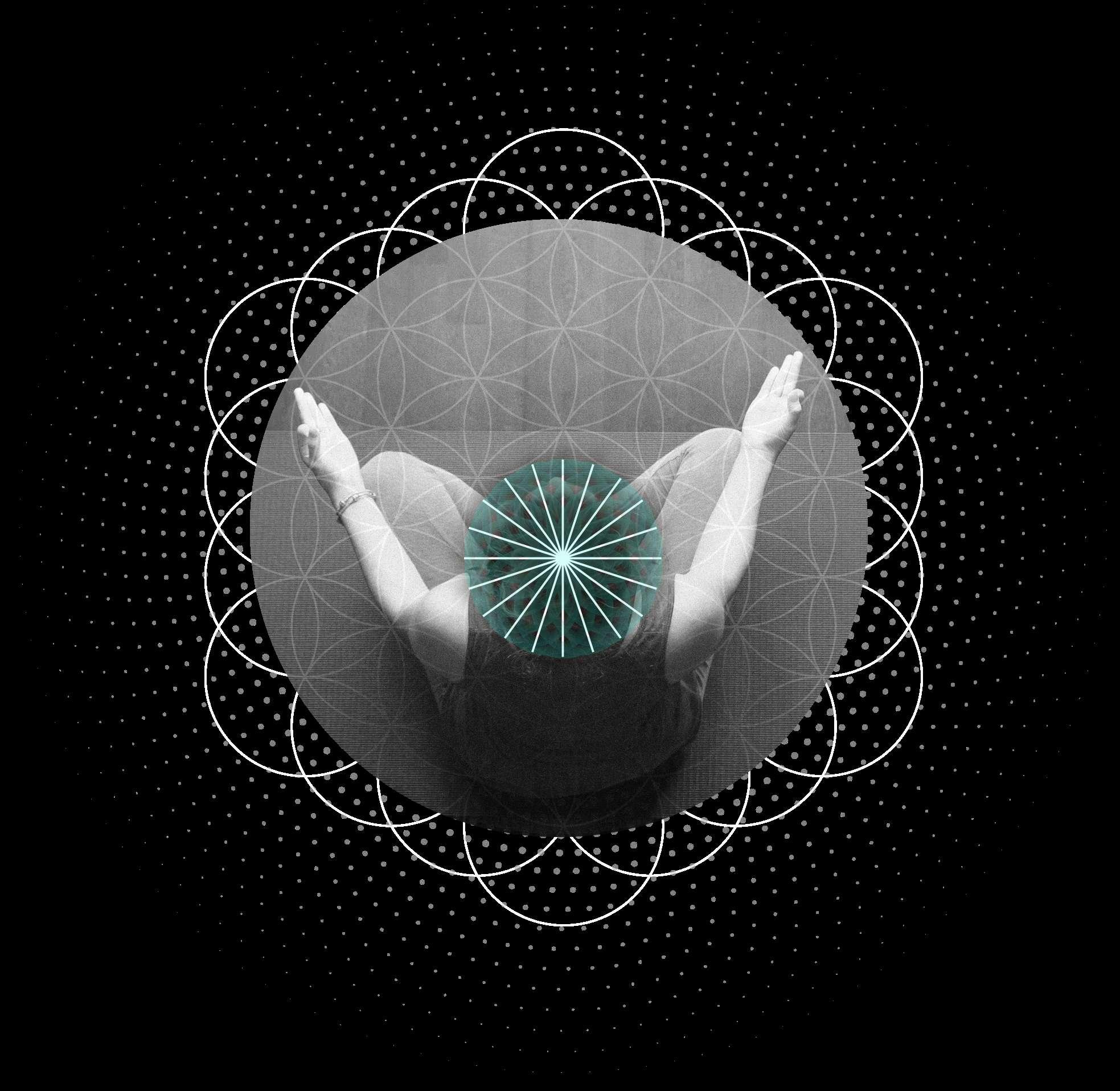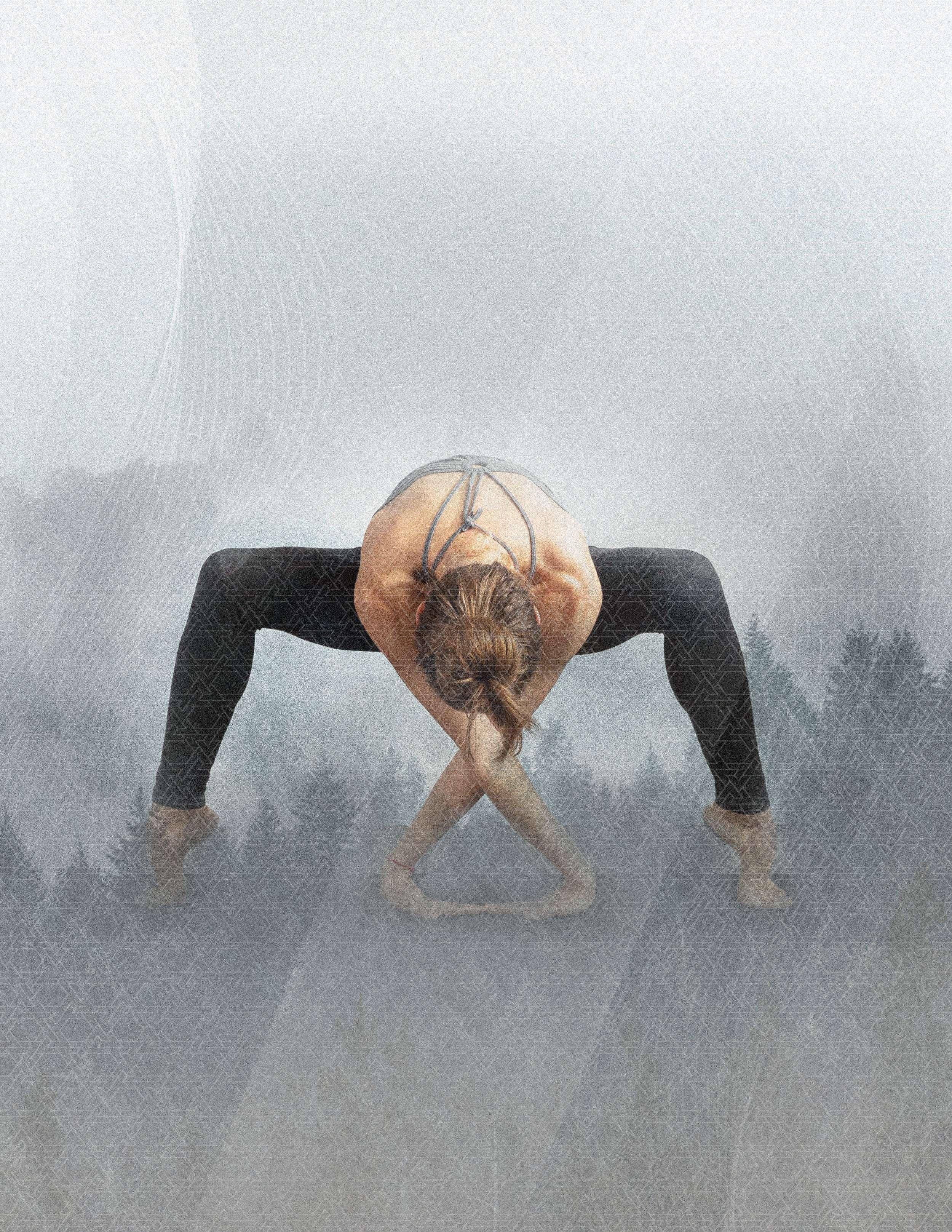
11 minute read
MAPPING THE INNER BODY
KEY TERMS
Granthi Chakra Ney Drop Muladhara Svadisthana Manipura Anahatha Vishuddha Sahasrara
Advertisement
Granthis, knotted hoses, and nadi formation
If we are meant to live in bodies made of light, why do some of us relate to our bodies as made of flesh, blood, and bone and that grow old and stop working? This is because of the knots that choke our central channel. The three main channels do not go perfectly straight up and down along our spine. In fact, the two side channels twist themselves around our central channel forming knots. The Sanskrit word for these knots is granthi. These granthis create problems inside our bodies and are the mechanism that make us see ourselves grow old. This mechanism can be explained with the metaphor of a hose. Imagine a hose with water flowing through it. If that hose becomes knotted, what happens? Because the water can’t pass through, the hose will balloon. Imagine there was a huge amount of pressure in the hose. What will inevitably happen? The hose will burst and water will shoot out in many directions. Imagine your central channel as a perfectly straight hose. Now take your ida and pingala channels and twist them around the central channel once. If there is no prana running through the side channels (water in the hose) then the central channel can continue to flow. However, when prana does run through the side
channels then they will expand, tightening the granthis and choking the central channel. The backed-up prana then bursts out of the sushumna shooting out new nadis in many directions.
New Nadis New Nadis
Granthi
Chakra

New Nadis

What chakras really are and how they kill you
In deep meditation, it is possible to look at the central channel from the above looking down, with a birds-eye view. What is seen from this perspective looks like a wheel where the granthi is like the center of the wheel and the new nadis bursting outward look like the spokes of the wheel. This phenomenon is called a chakra, which is Sanskrit for wheel. These chakras are the result of choke points and from these choke points, more channels are formed. Traditionally in yoga 72,000 different channels are described. These are the channels that allow prana to flow to every tip of the body.
Usually we see pictures of these chakras as sources of radiant light. They are depicted as good and beautiful, and inspiring awe. Make no mistake: the stark reality is that chakras kill you. Chakras are the way that your body will die. As we push more and more prana into our side channels due to our mistaken views of reality, the blocks and knots become stiffer and stronger, eventually inhibiting the flow of prana entirely. This causes our bodies to deform, deteriorate, and die. Chakras create negative emotions. They create illness. They cause suffering. They are a mistake. The goal of Lady Niguma’s yoga is to remove these choke points so the energy can flow smoothly, to eliminate the negative emotions, to remove sickness, and even to remove death.
Opening chakras and untangling knots
When we hear about “opening chakras” what is really meant is the loosening of granthis, or knots, so that prana can flow more easily through our sushumna. Though chakras may seem elusive at first, a dedicated practitioner will develop an intimate relationship with their subtle bodies, especially the chakras. Lady Niguma’s yoga offers us the wisdom that teaches us how to connect and influence these subtle components of our body. Chakras express themselves not only as our body, but also as emotions. This relationship is a main focus of Lady Niguma Level 2. Generally speaking, however, you will know that you have loosened or opened a chakra when you feel increased compassion, mental clarity, and overall energy. As well, contemplation practice becomes focused and our capacity to understand philosophical concepts becomes more subtle and profound. Lady Niguma focuses on how we can release the pressure in our knots. Even if you can’t control your mind, you can control your body in asana and with that you change your chakras. Outer methods are like banging on a clogged kitchen pipe from the outside. We use practices like the asanas or postures, we control the breath with pranayama, and we keep our ethical morality. Inner practices clean these clogged kitchen pipes from the inside, like by removing a blockage in a pipe with a long stick. Inner practices include contemplation,

thoughts of love and compassion, visualization techniques, and the wisdom that understands seeds. We use inner and outer yoga methods to untangle these knots and allow the prana in the right or the “ha” channel as well as the prana in the left or “tha” channel to flow into the central channel. Remember, yoga means “to join” and so we “yoga” or join the winds from the “ha” channel with the winds of the “tha’ channel into the central channel. We “ha-tha yoga”! This is the real meaning, the deepest meaning of hatha yoga. Hatha yoga isn’t about yoga poses or a flowing yoga series. Hatha yoga is about bringing the winds into the central channel. And when we do that we eliminate negative emotions. Forever. We experience physical and mental bliss. We understand seeds and see emptiness directly and our heart is filled with love and compassion. These are the real goals of yoga.
Neys and Drops
The topic of neys and drops are fundamental to Lady Niguma’s yoga. In this course we will present a broad overview and definition of these two components and then again much more rigorously in Levels 2 and 3. A ney is translated as a crucial point. These are points where we work on the body at the middle of the chakras. Unlike chakras and channels, neys are specific locations. If one were to trace all the nadis backward toward the center, they would all come to a single point, like the GPS coordinates that mark the absolute center of a chakra. In the analogy of “all roads lead back to Rome,” you could say “all nadis lead back to a ney.” Drops are the essence of who we are. There are many drops and they move throughout our body. Lady Niguma’s yoga focuses on methods to crack open specific drops. By bringing our prana to these critical points, we are able to rapidly accelerate the transformation of our negative emotions and to transform our bodies - by understanding the subtle body, or body of light.

The Root Chakra
“Root Chakra” is the English name for the Muladhara Chakra. The Sanskrit word muladhara is made up of two parts: mula and adhara.Mula in Sanskrit means root, and the corresponding Tibetan is tsa. The same Sanskrit root appears in the English mural, meaning a “painting on a wall,” since a wall was a strong foundation or root for a building. Adhara, or ten in Tibetan, means basis.This ultimately comes from the Sanskrit root √dhir, which means “to hold firm. ”This same root is found in the very common Sanskrit word dharma, which can mean “spiritual way” but has the more basic meaning of a thing: anything that “holds” its own essence. We find this root in the English words tree (a firmly-rooted plant); true (firm); and farm (a holding of land). Adhara means basis. This ultimately comes from the Sanskrit root √dhir, which means “to hold firm. ”This same root is found in the very common Sanskrit word dharma, which can mean “spiritual way” but has the more basic meaning of a thing: anything that “holds” its own essence. We find this root in the English words tree (a firmly-rooted plant); true (firm); and farm (a holding of land). The general location of the Root Chakra is in the perineum, or area of the groin, between the two legs. This chakra is generally related to sexual energy, especially in its spiritual form as a pure form of inner wind which can greatly aid in transforming the body into light.

The Chakra of the Seat of the Self
The Chakra of the Seat of the Self is called Svadhisthana Chakra in Sanskrit. The word svadhisthana is made of two parts, sva and adhistha. Sva means its own, or self, and is found in the English words self and suicide. Adhistha means a seat or place where something stays, and its root is found in the English words stay and station. This chakra is located four finger widths down the spine from the navel chakra.
The Chakra of the City of Jewels
The Chakra of the City of Jewels is called Manipura Chakra in Sanskrit. The word manipura is made of two parts: mani and pura. Mani means a jewel, and may be related to the English word mane, in the idea of an “ornament upon the neck.” Pura means full, and is found in the English full and ball. In olden times it very commonly meant “full of people,” and thus a town or city. We see it at the end of many cities in India as well as in Singapore(City of the Lions). This chakra is located at the level of the navel, and is related again to sexual energy and its pure form of inner fire; imagine the spark of fire within a ruby.
The Unstruck Chakra
The Sansksrit name for the Unstruck Chakra is Anahata Chakra. Again, anahata is made of two words, an and ahata. An is a form of a, which is the negative in Sanskrit: not. We find it at the beginning of English words such as atheist (not believing in God) and apathetic (not passionate). Hata means struck or beaten in the sense of hitting a drum or a bell.It comes from the Sanskrit root √han, which means to strike or to smite. This root is found in the Sanskrit word ahinsa (non-violence) and the English word gun (an instrument for violence). The Unstruck Chakra is found at the level of the heart, and the general idea is that the beating of the heart is something which occurs from the heart itself, and not because someone has struck it like a drum. The Tibetans call this chakra the Chakra of All Things (Chukyi Korlo), since within it lies a tiny drop where all our karmas are stored, and from which all things in our world, and ourselves, emanate. This chakra is thus related with the creation of the world, and is also the place where we first experience ultimate love. This chakra is related with the creation of the world, and is also the place where we first experience ultimate love.

The Chakra of Purity
The Sanskrit name for the Chakra of Purity is Vishuddhi Chakra. The Sanskrit root here is √shudh, meaning to purify. This is probably related to English words meaning to shine, such as shine, sky,and scintillate. The Tibetans call this chakra the Chakra of Experience (Longchu Kyi Korlo). The point is that this chakra is located at the level of the throat or base of the neck, and the inner winds related to it play a role in the experience of food and drink— the beginning of the process where these substances are purified for use by the body. This chakra is called the Chakra of Experience because it is located at the level of the throat or base of the neck. The inner winds related to it play a role in the experience of food and drink—the beginning of the process where these substances are purified for use by the body.
The Chakra of Command
The Sanskrit name for the Chakra of Command is Ajnya Chakra. The word ajnya comes from the root √jnya, which means to know; the prefix a- makes it to inform or to command. We see this same root in the English know and ignorant (where the prefix i- is negative). The Tibetans call this chakra the Chakra of the Third Eye, or literally “The Chakra between the Two Eyebrows” (Min-tsam Gyi Korlo). Sometimes it is said to be located more generally in the middle of the forehead. This chakra is called the Chakra of the Third Eye, or literally “The Chakra between the Two Eyebrows”. Sometimes it is said to be located more generally in the middle of the forehead. This chakra plays a major role in allowing us to focus or direct our mind on an object, and we’ll be using it for this purpose throughout Heart Yoga.

The Chakra of a Thousand Petals
The Sanskrit name for the Chakra of a Thousand Petals is Sahasrara Chakra. The word sahasrara has two parts, sahasra and ara. Sahasra means a thousand, and ara means a spoke of a wheel, or petals of a chakra. The Tibetans refer to this chakra as the Chakra of Great Bliss (Dechen gyi korlo).The name derives from the sensation one feels when special substances at this chakra melt down during successful yogic practice. This is known as the Chakra of Great Bliss. The name derives from the sensation one feels when special substances at this chakra melt down during successful yogic practice.





